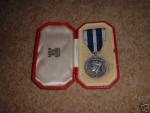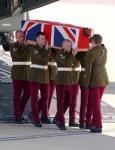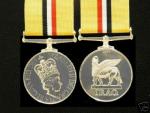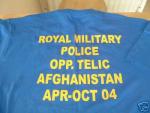-
Posts
3,575 -
Joined
-
Last visited
-
Days Won
27
Content Type
Profiles
Forums
Blogs
Gallery
Events
Store
Everything posted by bigjarofwasps
-
The reverse. Silver Gilt & Blue Enamel Masonic Jewel "North Wales" 1921,inscription to reverse "To Wilfred from Cyssu Xmas 1921,showing Compasses enclosing an open book with two equilateral triangle"s with point"s downwards
-
-

Op Telic Casualties & Fatalities
bigjarofwasps replied to bigjarofwasps's topic in Modern Campaigns and Conflicts
Death of British Serviceman in Iraq - Signaller Paul William Didsbury, 21st Signal Regiment (Air Support) Published Friday 1st July 2005 Signaller Paul William Didsbury, 21st Signal Regiment (Air Support) It is with deep regret that the Ministry of Defence has to confirm that on the morning of Wednesday 29 June 2005, Signaller Paul William Didsbury, a soldier with 21st Signal Regiment (Air Support), died in a tragic accident at Basra. He was serving on a roulement tour with the Joint Helicopter Force (Iraq). Signaller Didsbury, aged 18, was single and served with the Royal Signals. He was born in Blackpool. Lt Col Olly Halstead, Commanding Officer, paid tribute to Signaller Didsbury: "Signaller Didsbury was known as 'Dids' to all within my Regiment. He was an outgoing and irrepressibly cheerful soldier who was very well known and hugely popular throughout the Regiment. Always keen to try new things, he seized every opportunity to broaden his horizons and relished the challenges that operations in Iraq offered. Fit, bright and a capable operator, what set Signaller Didsbury apart was his enthusiasm and zest for life. "Signaller Didsbury's death is a tragic blow to everyone and I offer my most sincere condolences, along with those of all in my Regiment, to his family ? with whom our thoughts and prayers lie right now. His death will be felt by all those who have been privileged to serve alongside him." The family have asked that the media respect their privacy at this very difficult time. -
Hi Guys, I see in this months Medal News, that theres a book recently published about the Cyprus campaign, in the 50`s. It says that British Police Officers, where invloved in the campaign. I`m curious to know whether these Officers were sent out from UK Constabularies, or did they form part of some Cyprus Police force, similiar to the Palestine Police? Has any seen or got a medal to one of these Officers? How much success have you had researching him? BJOW
-

PC.E EDWARDS
bigjarofwasps replied to a topic in Great Britain: Mervyn Mitton's British & Colonial Police Forces
And I thought I was a `Mutley`!!!!!! When it came to medals, ho,ho,ho. -
Hi, Just out of interest, has anyone got a copy of John Nicols book Tornado Down, handy? If so can you have a look and see if it gives a name or location of the first air force base he was taken too, after capture. I think I`m right in thinking it was near Basrah, I`m currently stationed at on old Iraqi/RAF air field near Basrah, I wonder if its the same one? The one I`m currently based in was build by the British in the 30`s I think? There is a smaller one just south of here, another just north in Basrah itself, and of course Basah international airport, so I maybe entirely wrong? But it would be interesting to know none the less. Hope someone can help. BJOW.
-

RFC Police?
bigjarofwasps replied to bigjarofwasps's topic in Great Britain: Research, Documentation & History
Cheers Luckyoldpig, that very interesting. Bigjarofwasps. -

Military use of the Gold Sovereign
bigjarofwasps replied to bigjarofwasps's topic in Coins & Commemorative Medallions
I`m still trying to confirm evidence of the use of gold sovereigns, during the current operations in Iraq, and during the war (2003), as yet I have drawn a blank. I can only hope that in the near future as more books start to be published on the subject, that maybe they`ll hold the answer. In the meantime I`d very much like to hear from anyone who can confirm or deny, the use of said coins during Telic. -
Hi, I was just reading this months medal news, the article in question was about an Officer who`d served in various campaigns and won several gallantry medals, the story went something like this.... So and so served in the Royal irish Rifles in palestine in 1938, winning the MC and bar, in 1944 he recieved an immidiate award of the DSO, then won it again at some later point, finally winning it again in Cyprus in 1957 as CO of the Paras. Anyway I`ve heard of these immidiate awards before, but can`t understand the difference between an immidiate award and a normal one, can anyone shine some light on this for me? I assume that an immidaite award is where some General or other, awards the medal there an then, and a normal award goes via the London Gazette, am I on the right track, or barking up the wrong tree entirely?? Hope someone can answer my question? BJOW.
-

Op Telic Casualties & Fatalities
bigjarofwasps replied to bigjarofwasps's topic in Modern Campaigns and Conflicts
Death of British Serviceman in Iraq - Lance Corporal Alan Brackenbury Published Sunday 29th May 2005 Lance Corporal Alan Brackenbury of The King's Royal Hussars.It is with very deep regret that the Ministry of Defence must confirm the death of Lance Corporal Alan Brackenbury of The King's Royal Hussars, in the early hours of Sunday 29 May 2005, during an incident to the South of Al Amarah, Iraq. LCpl Brackenbury was serving with A Squadron, part of the 1 STAFFORDS battlegroup in Iraq. Aged 21, LCpl Brackenbury was from East Riding, Yorkshire. He joined the Army in 2000 and was promoted to Lance Corporal in 2005. Alan is survived by his father Stephen, mother Janet, brother David, and sister Faye. His father said: "Alan loved being in the army - it was all he had ever wanted to do. He was immensely proud to be a soldier and we were immensely proud that he was a soldier. It is some comfort to us, as we grieve for Alan, that he died doing what he loved so much." The family has asked not to be contacted by the media. Commanding Officer of the King's Royal Hussars Lieutentant Colonel Toby Bridge said: "Cpl Brackenbury's death is a desperate loss to his family, and his girlfriend, and a tragic blow to his friends. "Cpl Brackenbury died instantly when his patrol was attacked by a roadside bomb as it drove to a meeting with the Iraqi Border Police. He was in the first of three land-rovers in the patrol when it was struck by an Improvised Explosive Device. The explosion killed Cpl Brackenbury and injured four other soldiers - all of whom were rapidly evacuated by helicopter and are now in a stable condition. Cpl Brackenbury was declared dead on his arrival at the medical facility in the nearby British Camp. "Cpl Brackenbury lived life to the full. He had a passion for racing, football and fishing. Above all we will remember his tremendous sense of humour, and fun, and his willingness to try something new. I was utterly delighted in March when Cpl Brackenbury was promoted from Trooper at the early age of 20. He was definitely a man of the future. "Cpl Brackenbury was hugely popular and a real contributor to whatever he undertook. His death will be felt by all those who have been privileged to serve alongside him." "On behalf of all his comrades in the Regiment and the STAFFORDS Battlegroup I want to offer our condolences to his family and girlfriend and to say that you are all in our thoughts and prayers." -
The Operational Service Medal (OSM) was introduced in 1999 and effective from 1st January 2000. It is intended to replace the Campaign Service Medal (CSM) for minor campaigns that are not awarded their own seperate medal (with the exception of operations in Northern Ireland and Air Operations Over Iraq which continues to see the CSM awarded). It seems likely that a seperate ribbon will be awarded for each minor campaign (similar to the UN medal). Two ribbons have so far been awarded the first for Sierra Leone and the second for Afghanistan. Obverse: The crowned effigy of HM Queen Elizabeth II. Reverse: A four pointed star with a crown between each arm of the star resting on a sword. In the centre is a cicular disc containing the Union Flag made from a central cross and the blades of the swords. Around the disc is the inscription 'FOR OPERATIONAL SERVICE'. The picture below has the Sierra Leone ribbon, but the medal its self is the same for Afgan.
-
The British medal for Afganistan, is a nice one. It`s very similar to the old GSM, and has your details on it. Anyway saw this nonsense on ebay, and thought I`d share it with you........... A FANTASTIC BRAND NEW NEVER WORN SIZE XL BLUE OPERATION TELIC AFGHANISTAN 04 TOUR T-SHIRT. THIS OPERATION WAS A FOLLOW ON MISSION FROM TELIC IRAQ AND SHARED THE SAME OPERATIONAL NAME. THIS SHIRT WAS TO BE WORN ON LIGHT DUTIES BUT THIS ONE WAS NEVER WORN. THE WRITING IS IN YELLOW AND IS ON THE BACK WITH THE RMP CREST ON THE FRONT. Not only is Op Telic ONLY for Iraq, Afgan has had several different Op names, but the amry call them Op`s NOT Opp`s. I can only assume that this T Shirt is a bogus one and nothing to do with the RMP at all. Does anyone know different?
-
Hi Paul, Don`t know whether the KPM is first or second type, as you say its impossible to tell from this picture. I assume that its first type given the fact that theres no defence medal in the group, also interestingly there`s no LSGC either. But there can`t be that many KPM/OBE winners surely. I`ll do a bit of digging and see what I can come up with. Gordon.
-
A GROUP OF SEVEN MINIATURE MEDALS COMPRISING A MILITARY OBE , KINGS POLICE MEDAL , BRITISH WAR MEDAL , VICTORY MEDAL , INDIA GENERAL SERVICE WITH CLASP AFGHANISTAN N.W.F. 1919 , 1935 JUBILEE MEDAL AND 1937 CORONATION MEDAL. THE GROUP IS MOUNTED ON A ' SPINK & SON ' BAR FOR WEAR. Anyone any idea who these medals might be attributed to? :coola: BJOW












